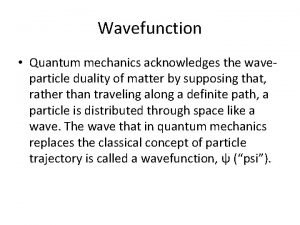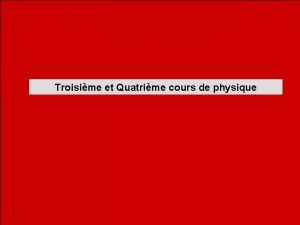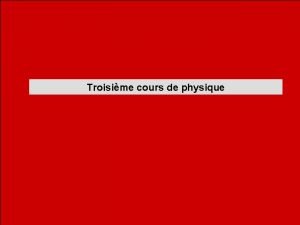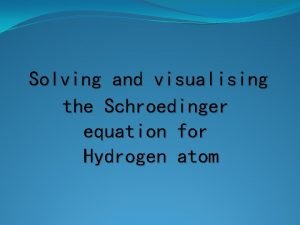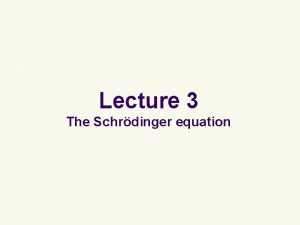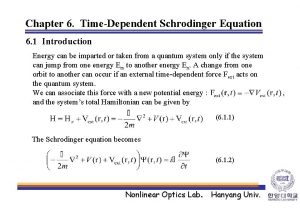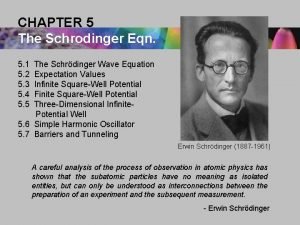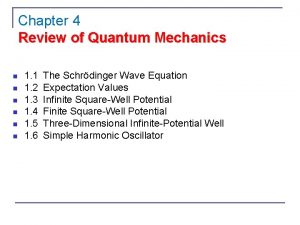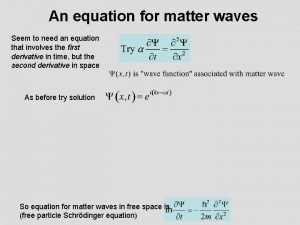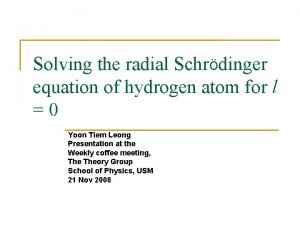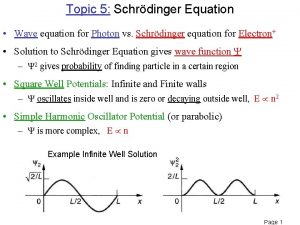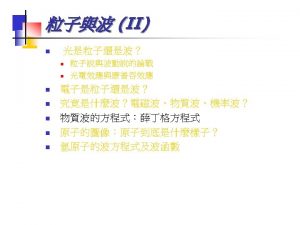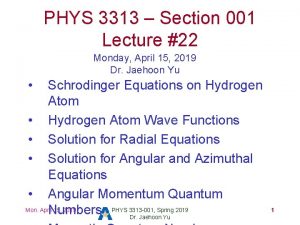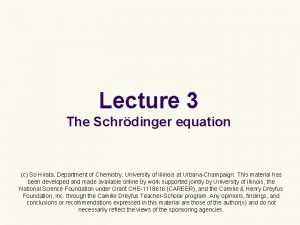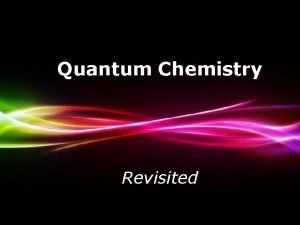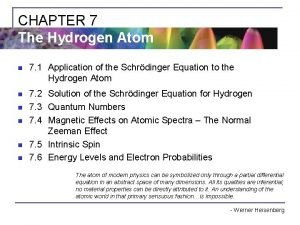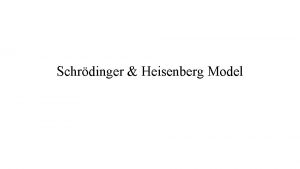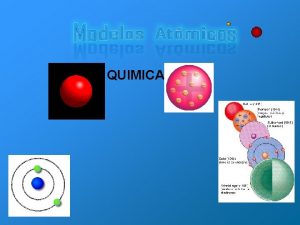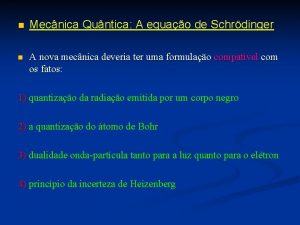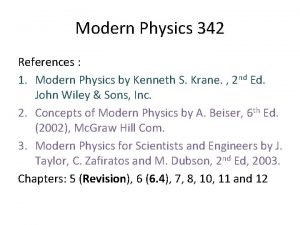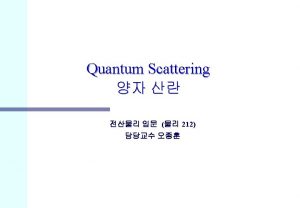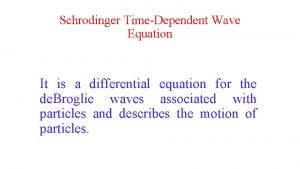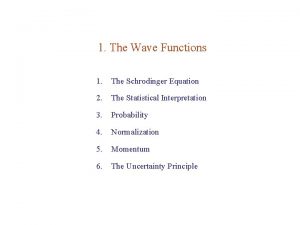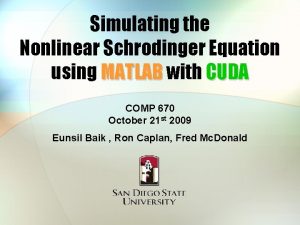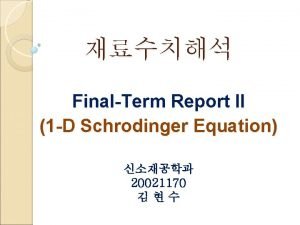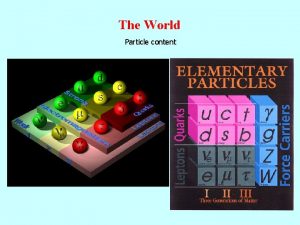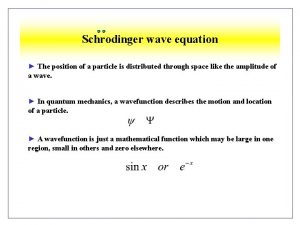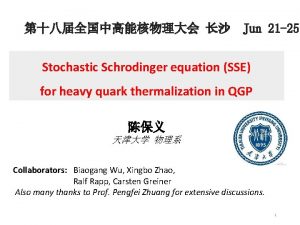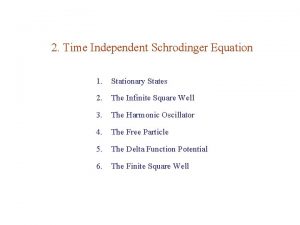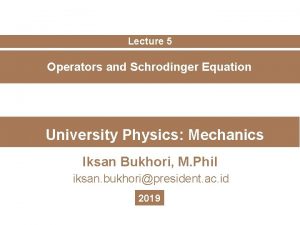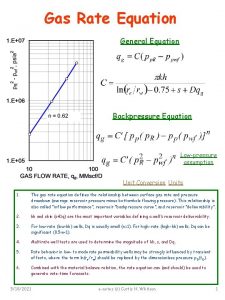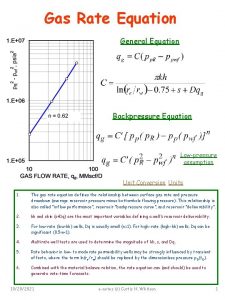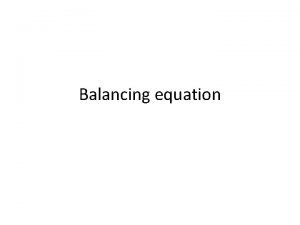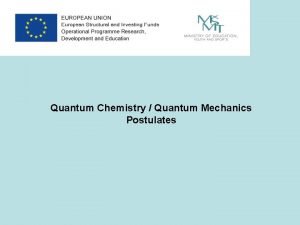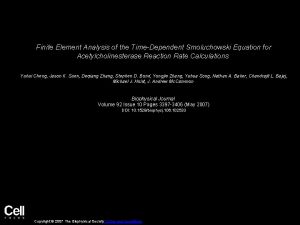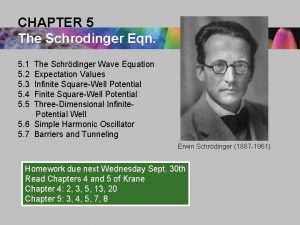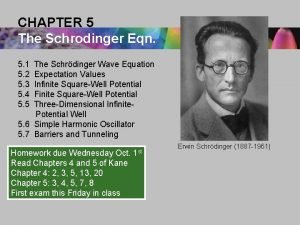Chapter 6 TimeDependent Schrodinger Equation 6 1 Introduction





















- Slides: 21

Chapter 6. Time-Dependent Schrodinger Equation 6. 1 Introduction Energy can be imparted or taken from a quantum system only if the system can jump from one energy Em to another energy En. A change from one orbit to another can occur if an external time-dependent force Fext acts on the quantum system. We can associate this force with a new potential energy : and the system’s total Hamiltonian can be given by (6. 1. 1) The Schrodinger equation becomes (6. 1. 2) Nonlinear Optics Lab. Hanyang Univ. ,

6. 2 Time-Dependent Solutions Time-independent Schrodinger equation ; * : Complete & Orthonormal => Any function can be expressed by the Following Dirac, the exact time-dependent wave function can be expressed by a sum of ; (6. 2. 1) (6. 1. 2) => (6. 2. 2) (6. 2. 3) Nonlinear Optics Lab. Hanyang Univ.

: time-dependent Schrodinger equation (6. 2. 7) where, <Meaning of : probability amplitude> Nonlinear Optics Lab. Probability that the quantum system is in its m-th orbit. Hanyang Univ.

6. 3 Two-State Quantum Systems and Sinusoidal External Forces Time-dependent potential for the interaction between an EM field an electron ; : dipole approximation For a monochromatic wave, Put, (6. 3. 1) For a two-state system, (6. 2. 8) (6. 3. 4) 0 Nonlinear Optics Lab. Hanyang Univ.

Normalization condition ; (6. 2. 7), (6. 3. 1) => where, Define, Set, (6. 3. 4) => : Rabi frequency (field-atom interaction energy in freq. unit) Nonlinear Optics Lab. (6. 3. 11) Hanyang Univ.

i) ( radiation field=0) ii) ( nearly resonant radiation field) trial solution, Neglected by rotating-wave approximation (6. 3. 11) => where, : detuning : Rabi frequency Nonlinear Optics Lab. Hanyang Univ.

Solution) initial condition ; where, : Generalized Rabi frequency Probability ; Nonlinear Optics Lab. Hanyang Univ.

6. 4 Quantum Mechanics and the Lorentz Model - Lorentz (classical) model can’t give the oscillator stength, - Why the classical model offers good explanation for a wide variety of phenomena ? Basic dynamic variable for an atomic electron : Displaceement, Corresponding quantum displacement : expectation value, in classical model, For the two-state atom, where, Nonlinear Optics Lab. Hanyang Univ.

For a case of linear polarization, Since where, Nonlinear Optics Lab. Hanyang Univ.

If we assume, Suppose the E-field points in the z-direction, example) Let atomic state 1 and 2 be the 100 and 210 (1 S and 2 P) Nonlinear Optics Lab. Hanyang Univ.

Homework : Appendix 5. A ! Table 6. 1, 6. 2, where, cf) : Bohr radius in classical model Nonlinear Optics Lab. Hanyang Univ.

Classic Quantum mechanics Oscillator Strength : (3. 7. 5) example) Hydrogen n=1 => n=2, Nonlinear Optics Lab. Hanyang Univ.

6. 5 Density Matrix and (Collisional) Relaxation Two level system, time-dependent Schrodinger equation, (6. 3. 2) (6. 3. 14) Via (6. 4. 3), , the combination variable are more useful than either Nonlinear Optics Lab. Hanyang Univ.

Define, similarly, Nonlinear Optics Lab. Hanyang Univ.

The equations are not yet in their most useful form, since they do not reflect the existence of relaxation such as collision. <Relaxation Processes> (6. 3. 14) => Nonlinear Optics Lab. Hanyang Univ.

Average value This result can also be reached by a simple modification of the original equation of motion ; Similarly, Nonlinear Optics Lab. Hanyang Univ.

2 G 2 A 21 1 G 1 (6. 5. 2) => Nonlinear Optics Lab. Hanyang Univ.

(6. 5. 2) => where, : total relaxation rate Nonlinear Optics Lab. Hanyang Univ.

<Special case> No dynamic information ! So, we can pay attention solely to the differences, Nonlinear Optics Lab. Hanyang Univ.

(Chapter 8 : Bloch equation) The notation used for : density matrix Nonlinear Optics Lab. Hanyang Univ.

Nonlinear Optics Lab. Hanyang Univ.
 Physically acceptable wave function
Physically acceptable wave function Physique
Physique Equation de schrodinger
Equation de schrodinger Solving schrodinger equation for hydrogen atom
Solving schrodinger equation for hydrogen atom Schrdinger
Schrdinger Schrodinger time dependent equation
Schrodinger time dependent equation General solution of wave equation
General solution of wave equation Review of quantum mechanics
Review of quantum mechanics Time independent schrodinger equation
Time independent schrodinger equation Particle in three dimensional box
Particle in three dimensional box Schrodinger equation radial solution
Schrodinger equation radial solution Expectation value of energy in quantum mechanics
Expectation value of energy in quantum mechanics Schrodinger equation
Schrodinger equation Uses of schrodinger wave equation
Uses of schrodinger wave equation So hirata
So hirata Klein-gordon equation ppt
Klein-gordon equation ppt Hydrogen schrodinger equation
Hydrogen schrodinger equation Persamaan schrodinger
Persamaan schrodinger Schrodinger and heisenberg model
Schrodinger and heisenberg model Mg modelo de dalton
Mg modelo de dalton Equação de schrodinger
Equação de schrodinger Schrodinger hypothesis
Schrodinger hypothesis
